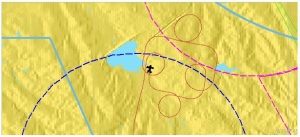The instrument ground school will soon come to an end, so I thought it might be time to start flight training. I had a lesson in the Redbird FMX full motion simulator which will be the training device for my first ten hours in instrument meteorological conditions. We called it an introductory flight but there was already a lot to learn.
 Aspen Flying Club, Redbird FMX
Aspen Flying Club, Redbird FMX The Oscar Pattern
The Oscar Pattern The Oscar Pattern in FSX (not perfect yet!)
The Oscar Pattern in FSX (not perfect yet!)During my first sim session Josh, my CFI, didn’t want me to think it was too easy so he failed the vacuum pump. This vacuum is the driving force for the gyroscopic instruments, usually the directional gyro or heading indicator and the attitude indicator (red arrows). My brain was really tricking me – I kept looking at the unreliable instruments and struggled to keep the airplane under control. To make it worse I had to use the magnetic compass (German ugs., Schnapskompass) and think about its errors during turns. The acronym for that is UNOS, undershoot north overshoot south. During a turn a magnetic compass is only accurate when passing through a east or westerly heading. Thus it is easier to time the turns, which are always done at standard rate: 3 degrees per second. A 90 degree turn divided by 3 equals a 30 second standard rate turn. Start the turn and stop watch and after 30 seconds – if flown accurately enough – you end up on your desired heading. During the exercise I became so confused by the false indications of the failed instruments that my CFI had to cover them with post-its. Now after flying some time at home I get better at it but I certainly see the danger of that instrument failure in clouds. I suppose that if you are a bit behind the airplane this situation could become very serious. Well, that is at least motivation to study and a reminder that pilots should always fight complacency to stay ahead of the game.
 Vacuum failure – note the attitude indicator showing anything but the right attitude
Vacuum failure – note the attitude indicator showing anything but the right attitude
NIce post. I can perfectly understand your situation, I am doing night vfr training and basic instrument flying (which takes 10 hours), and sometimes it is pretty challenging to scan all the instruments and keep the plane where you want to have it. But it is about learning and advance. Safe flights! 🙂
LikeLike
Thanks for your comment! I love it to be challenged and sometimes it is good to see that there is still a whole lot to learn. Happy landings, Florian
LikeLike